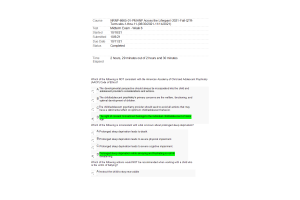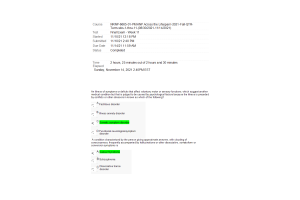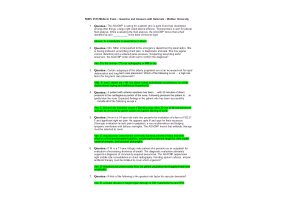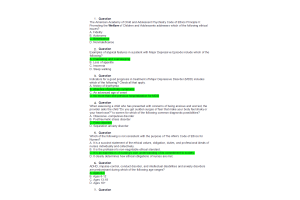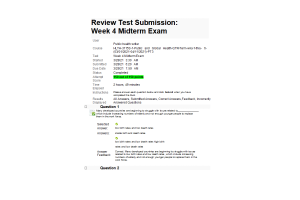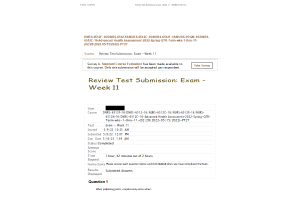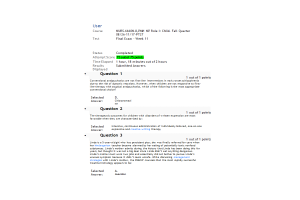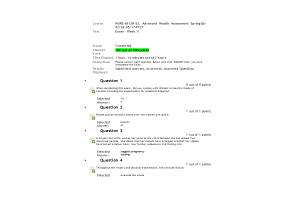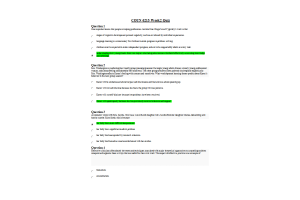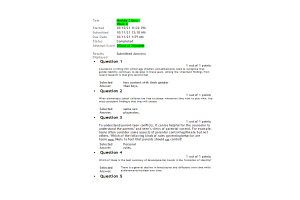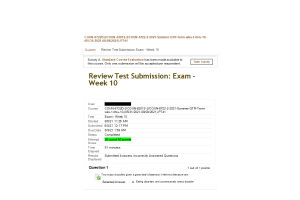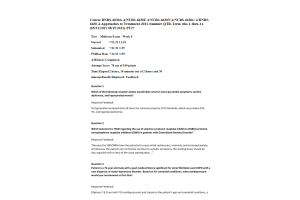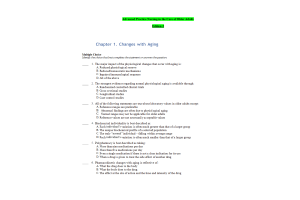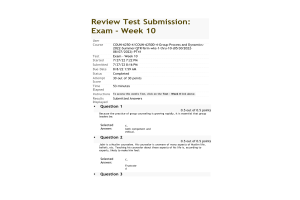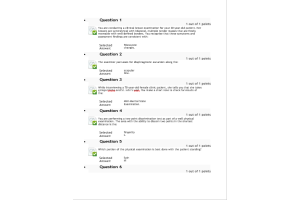NURS 6501 Week 6 Midterm Exam
- $75.00
- Question: Incomplete fusion of the nasomedial and intermaxillary process during the fourth week of embryonic development causes which condition in an infant?
- Question: Increased gastrin secretion by the mother in the last trimester of pregnancy may cause which condition in the infant?
- Question: Parents report their 3-week-old infant who eats well and has gained weight began to vomit forcefully for no apparent reason. What treatment option does the healthcare professional prepare to educate the parent on?
- Question: Which term is used to identify a condition in which the developing colon remains in the upper right quadrant instead of moving to its normal location?
- Question: Which term is used to identify an intestinal obstruction caused by meconium formed in utero that is abnormally sticky and adheres firmly to the mucosa of the small intestine?
- Question: A newborn has meconium ileus. What diagnostic test does the healthcare professional advise the parents about?
- Question: Congenital aganglionic megacolon (Hirschsprung's disease) involves inadequate motility of the colon caused by neural malformation of which nervous system?
- Question: An infant has been diagnosed with intussusception and the student asks the healthcare professional to explain the condition. What explanation by the professional is MOST accurate?
- Question: An infant suddenly develops abdominal pain, becomes irritable, and draws up the knees. Vomiting occurs soon afterward. The mother reports that the infant passed a normal stool, followed by one that looked like currant jelly. What treatment does the healthcare professional prepare the infant for?
- Question: Cystic fibrosis is characterized by which symptom?
- Question: A child has cystic fibrosis (CF). Which medication does the healthcare professional teach the parents about?
- Question: What causes a person with cystic fibrosis to experience an exocrine pancreatic insufficiency?
- Question: A student asks the professor to explain the characteristic appearance of stools in people with cystic fibrosis. What explanation by the professor is BEST?
- Question: Which disorder is characterized by damage to the mucosa of the duodenum and jejunum and impaired secretion of secretin, cholecystokinin, and pancreatic enzymes?
- Question: An infant has gluten-sensitive enteropathy and the parents ask the healthcare professional to explain why the baby bruises so easily. The professional explains that the baby has which deficit?
- Question: What does the student learn distinguishes kwashiorkor from marasmus?
- Question: Why is prolonged diarrhea more severe in children than it is in adults?
- Question: A newborn baby displays jaundice 20-hours after birth. What action by the healthcare professional is MOST appropriate?
- Question: What is physiologic jaundice in a newborn caused by?
- Question: A woman who is positive for hepatitis B is in labor. What action by the healthcare professional is MOST appropriate?
- Question: Cirrhosis causes intrahepatic portal hypertension in children as a result of which mechanism?
- Question: A child has chronic hepatitis and the healthcare professional wants to assess the child for portal hypertension. what action by the professional is MOST appropriate?
- Question: Where in the brain is the vomiting center located?
- Question: Anti-emetic agents, such as domperidone and metoclopramide, are antagonists for which receptors?
- Question: A patient in the clinic reports projectile vomiting without nausea or other gastrointestinal symptoms. What action by the healthcare professional is MOST appropriate?
- Question: A patient reports feeling constipated. When assessing this patient, how often should the patient report bowel movements to be considered within the normal range?
- Question: How many stools per day are considered the upper limits of normal?
- Question: The adult intestine processes approximately how many liters of luminal content per day?
- Question: A person who has cholera (Vibrio cholerae) would be expected to have which type of diarrhea?
- Question: What type of diarrhea is a result of lactase deficiency?
- Question: A professor has taught the students about the pathogenesis of abdominal pain. Which statement by a student indicates the professor needs to review the material?
- Question: How can abdominal pain that is visceral in nature BEST be described?
- Question: A patient asks the healthcare professional to describe the cause of gastroesophageal reflux disease disease (GERD). What response by the professional is BEST?
- Question: A patient has frank bleeding of the rectum. How does the healthcare professional document this finding?
- Question: What is the cause of functional dysphagia?
- Question: By what mechanism does intussusception cause an intestinal obstruction?
- Question: A patient has been admitted for a possible small intestinal obstruction. What is the first sign the healthcare professional assesses for that would indicate the presence of this condition?
- Question: A patient has been admitted to the hospital with a possible bowel obstruction. Which assessment finding would alert the healthcare professional that the obstruction is in the small vs. large intestine?
- Question: A patient has chronic gastritis. What treatment does the healthcare professional educate the patient on?
- Question: A peptic ulcer may occur inn all of these areas except which?
- Question: A patient reports dumping syndrome after a partial gastrectomy. What does the healthcare professional teach this patient?
- Question: The most common clinical manifestation of portal hypertension is _____ bleeding.
- Question: A patient has portal hypertension-induced splenomegaly. Which lab value would the healthcare professional associate with this condition?
- Question: Hepatic fat accumulation is seen in which form of cirrhosis?
- Question: A student asks the healthcare professional to explain the pathophysiologic process of alcoholic cirrhosis. What statement by the professional would not be consistent with complete knowledge about this process.
- Question: A student learns what information about acute pancreatitis?
- Question: In the mouth and stomach, salivary a-amylase initiates the digestion of which nutrients?
- Question: Saliva contains which immunoglobulin (Ig)?
- Question: What effect is a result of inhibiting the PNS with a drug such as atropine?
- Question: Food enters the stomach via which orifice or sphincter?
- Question: Which gastric cells secrete hydrochloric acid and intrinsic factor?
- Question: Which cells in the stomach secrete histamine?
- Question: Which gastric hormone inhibits acid and pepsinogen secretion as well as the release of gastrin?
- Question: Which enzyme breaks down protein-forming polypeptides in the stomach?
- Question: Exposure to which substance protects the mucosal barrier of the stomach?
- Question: The ileum and jejunum are suspended by folds of the peritoneum that contain an extensive vascular and nervous network. What are these folds called?
- Question: Where in the small intestines are lymphocytes, plasma cells, and macrophages produced?
- Question: The student asks the professor why water and electrolytes are transported in both directions through tight junctions and intercellular spaces rather than across cell membranes. What response by the professor is BEST?
- Question: Glucose transport enhances the absorption of which electrolyte?
- Question: What process is capable of increasing both intrathoracic and intraabdominal pressure, thereby facilitating defecation?
- Question: Which pancreatic enzyme is responsible for the breakdown of carbohydrates?
- Question: What is the primary source of physiologic iron?
- Question: A professor has taught a class of students about the characteristics of vitamin B12. Which statement by a student demonstrates a need for more education?
- Question: Which water-soluble vitamin is absorbed by passive diffusion?
- Question: Which vitamin facilitates the absorption of iron by the epithelial cells of the duodenum and jejunum?
- Question: What is the role of the normal intestinal bacterial flora?
- Question: How are Kupffer cells best described?
- Question: Bilirubin is a byproduct of the destruction of which aged cells?
- Question: The process of conjugation of bilirubin in the liver is BEST described as which transformation?
- Question: Which structure synthesizes clotting factors and the vitamin K necessary for hemostasis?
- Question: How many days does it take for the entire epithelial population of the small intestines to be replaced?
- Question: Which cardiac chambers have the thinnest wall and why?
- Question: Which chamber of the heart endures the highest pressures?
- Question: What is the process that ensures mitral and tricuspid valve closure after the ventricles are filled with blood?
- Question: Oxygenated blood flows through which vessel?
- Question: Occlusion of the left anterior descending artery during a myocardial infarction would interrupt blood supply to which structures?
- Question: The coronary sinus empties into which cardiac structure?
- Question: During the cardiac cycle, which structure directly delivers action potential to the ventricular myocardium?
- Question: What period follows depolarization of the myocardium and represents a period during which no new cardiac potential can be propagated?
- Question: A patient has a disorder affecting ventricular depolarization. What ECG finding would the healthcare professional associate with this condition?
- Question: A patient had a myocardial infarction that damaged the SA node, which is no longer functioning as the pacemaker of the heart. What heart rate would the healthcare provider expect the patient to have?
- Question: Where in the heart are the receptors for neurotransmitters located?
- Question: Within a physiologic range, what does an increase in left ventricular end-diastolic volume (preload) result in?
- Question: The healthcare professional explains to a student that the amount of volume of blood in the heart is directly related to the _____ of contraction.
- Question: Pressure in the left ventricle must exceed pressure in which structure before the left ventricle can eject blood?
- Question: A healthcare professional is caring for a patient who has continuous increases in left ventricular filling pressures. What disorder would the professional assess the patient for?
- Question: The resting heart rate in a healthy person is primarily under the control of which nervous system?
- Question: A healthcare professional cares for older adults in a skilled nursing facility. What should the professional assess for in these individuals related to cardiovascular functioning?
- Question: What is the most important negative inotropic agent?
- Question: The right lymphatic duct drains into which structure?
- Question: A patient had a motor vehicle crash and suffered critical injuries to the brainstem. What physiological responses would the healthcare professional expect to see?
- Question: What is an expected change in the cardiovascular system that occurs with aging?
- Question: What is the major determinant of the resistance that blood encounters as it flows through the systemic circulation?
- Question: What physical sign does the healthcare professional relate to the result of turbulent blood flow through a vessel?
- Question: What is the major effect of a calcium channel blocker such as verapamil on cardiac contractions?
- Question: When endothelial cells are injured, what alteration contributes to atherosclerosis?
- Question: Which factor is responsible for the hypertrophy of the myocardium associated with hypertension?
- Question: What pathologic change occurs to the kidney's glomeruli as a result of hypertension?
- Question: Regarding the endothelium, what is the difference between healthy vessel walls and those that promote clot formation?
- Question: A healthcare professional is caring for four patients. Which patient does the professional assess for pulmonary emboli (PE) as the priority?
- Question: Which statement best describes thromboangiitis obliterans (Buerger disease)?
- Question: A patient has been diagnosed with Raynaud disease and asks for an explanation. What statement by the healthcare professional is best?
- Question: A person wishes to reduce the risk of developing coronary artery disease. This person has a normal lipid panel. What risk factor reduction would the healthcare professional advise for this person?
- Question: Which substance primarily contains cholesterol and protein?
- Question: Which elevated value may be protective of the development of atherosclerosis?
- Question: Cardiac cells can withstand ischemic conditions and still return to a viable state for how many minutes?
- Question: A patient who had a myocardial infarction is going to cardiac rehabilitation where progressive exercise is monitored by health care professionals. When would this patient be most vulnerable to injury and complications?
- Question: A patient in the Emergency department is suspected of having a myocardial infarction (MI). The initial cardiac troponin 1 level was negative. What action by the healthcare professional is best?
- Question: What electrocardiogram (ECG) change would the healthcare professional assess for when a patient's myocardial infarction extends through the myocardium from the endocardium to the epicardium?
- Question: How does angiotensin II increase the workload of the heart after a myocardial infarction (MI)?
- Question: A patient reports sudden onset of severe chest pain that radiates to the back and worsens with breathing and when lying down. What action by the healthcareprofessional is most appropriate?
- Question: Which condition is a cause of acquired aortic regurgitation?
- Question: A patient in the clinic reports fever, arthralgia, a rash, and nosebleeds. What other information should the healthcare professional elicit from this patient?
- Question: A patient is diagnosed with chronic obstructive pulmonary disease (COPD) and has elevated pulmonary vascular resistance. Which complication would the health care professional assess the patient for?
- Question: What cardiac pathologic condition contributes to ventricular remodeling?
- Question: In systolic heart failure, what effect does the renin-angiotensin-aldosterone system (RAAS) have on stroke volume?
- Question: What is the cause of the dyspnea resulting from a thoracic aneurysm?
- Question: Which statement is true concerning the cells' ability to synthesize cholesterol?
- Question: What is the trigger for angina pectoris?
- Question: Most cardiovascular developments occur between which weeks of gestation?
- Question: The student studying pathophysiology learns which fact about circulation at birth?
- Question: When does systemic vascular resistance in infants begin to increase?
- Question: Which event triggers congenital heart defects that cause acyanotic congestive heart failure?
- Question: Older children with an unrepaired cardiac septal defect experience cyanosis because of which factor?
- Question: A baby has been born with Down syndrome. What congenital heart defect does the healthcare professional assess this baby for?
- Question: An infant has a crescendo-decrescendo systolic ejection murmur located between the second and third intercostal spaces along the left sternal border. The healthcare professional suspects an atrial septal defect (ASD). For what other manifestation does the healthcare professional assess to confirm the suspicion?
- Question: An infant has a loud, harsh, holosystolic murmur and systolic thrill that can be detected at the left lower sternal border that radiates to the neck. These clinical findings are consistent with which congenital heart defect?
- Question: Where can coarctation of the aorta (COA) be located?
- Question: A parent brings a 10-year-old child to the clinic and reports a mottled appearance to the skin and legs cramps when the child is in physical education class. What diagnostic testing or treatment does the healthcare professional prepare the family for?
- Question: What is the initial manifestation of aortic coarctation observed in a neonate?
- Question: A parent asks the healthcare professional to explain why a child diagnosed with Tetralogy of Fallot squats frequently. What explanation by the professional is best?
- Question: An infant diagnosed with a small patent ductus arteriosus (PDA) would likely exhibit which symptom?
- Question: A newborn has chronic sustained hypertension but otherwise appears healthy. What diagnostic testing does the healthcare professional facilitate as the priority?
- Question: Which condition is consistent with the cardiac defect of transposition of the great vessels?
- Question: Which scenario describes total anomalous pulmonary venous return?
- Question: A healthcare professional assesses a systolic ejection murmur at the right upper sternal border that transmits to the neck and left lower sternal border. What condition does the professional prepare to educate the parents on?
- Question: A healthcare professional is assessing a baby in the neonatal intensive care unit who is very unstable. The professional hears a systolic ejection click at the upper left sternal border with a thrill palpated at the upper left sternal border. What procedure does the professional prepare the parents for the baby to have?
- Question: Which heart defect results in a single vessel arising from both ventricles, providing blood to both the pulmonary and systemic circulations?
- Question: A 9-year-old child has a blood pressure of 112/72 mmHg in the school nurse's office. What action by the school nurse is most appropriate?
- Question: What pulmonary defense mechanism propels a mucous blanket that entraps particles moving toward the oropharynx?
- Question: Which term is used to identify the movement of gas and air into and out of the lungs?
- Question: When an individual aspirates food particles, where would the healthcare professional expect to hear decreased or absent breath sounds?
- Question: Where in the lung does gas exchange occur?
- Question: Surfactant produced by type II alveolar cells facilitates alveolar distention and ventilationby which mechanism?
- Question: Which describes the pressure in the pleural space?
- Question: A healthcare professional wants to determine the adequacy of a person's alveolar ventilation. What assessment finding is most important for the professional to consider?
- Question: Which normal physiologic change occurs in the aging pulmonary system?
- Question: Stretch receptors and peripheral chemoreceptors send afferent impulses regarding ventilation to which location in the brain?
- Question: If a patient develops acidosis, the nurse would expect the oxyhemoglobin dissociation curve to react in which manner?
- Question: The student asks the professor to explain what characteristic is demonstrated by lungs with decreased compliance?
- Question: The lung is innervated by the parasympathetic nervous system via which nerve?
- Question: What event is characteristic of the function in Zone 1 of the lung?
- Question: A healthcare professional tells the student that a properly placed endotracheal tube for mechanical ventilation is 5 to 7 cm above the tracheal bifurcation. Where does this bifurcation occur?
- How low must the partial pressure of arterial oxygen (PaO2) drop before the peripheral chemoreceptors influence ventilation?
- Question: Which receptors are located in the smooth muscles of airways?
- Question: Which receptors are located near the respiratory center?
- Question: A patient is having a spirometry measurement done and asks the healthcare professional to explain this test. What response by the professional is best?
- Question: A healthcare professional who works in a senior center knows about the effects of aging on the pulmonary system, which include which of these? (Select all that apply.)
- Question: Which of these cause the airway epithelium to constrict? (Select all that apply.)
- Question: Besides dyspnea, what is the most common characteristic associated with pulmonary disease?
- Question: A patient reports needing to sit up at night in order to breathe. What term does the healthcare professional document about this condition?
- Question: A hospitalized patient is complaining of shortness of breath, but the student does notnotice cyanosis. The patient's hemoglobin is 9 g/dL, so the student asks the healthcare professional to explain. The professional tells the student that what amount of hemoglobin must be desaturated before cyanosis occurs?
- Question: High altitudes may produce hypoxemia through which mechanism?
- Question: A patient has pulmonary edema. For what condition should the healthcare professional assess the patient as the priority?
- Question: A patient is brought to the Emergency Department with a gunshot wound to the chest. The healthcare professional assesses an abnormality involving a pleural rupture that acts as a one-way valve, permitting air to enter on inspiration but preventing its escape by closing during expiration. What action by the healthcare professional is the priority?
- Question: Which condition involves an abnormally enlarged gas-exchange system and the destruction of the lung's alveolar walls?
- Question: A patient has been diagnosed with pneumoconiosis and asks the healthcare professional to explain this disease. What description by the professional is best?
- Question: A patient has been diagnosed with acute respiratory distress syndrome (ARDS). Forwhat other health condition should the healthcare professional assess this patient for as the priority?
- Question: Which type of pulmonary disease requires more force to expire a volume of air?
- Question: Which immunoglobulin (Ig) may contribute to the pathophysiologic characteristics of asthma?
- Question: A healthcare professional is educating a patient about asthma. The professional states that good control is necessary due to which pathophysiologic process?
- Question: A patient comes to the Emergency Department with inspiratory and expiratory wheezing, dyspnea, nonproductive cough, and tachypnea. What treatment does the healthcare professional anticipate for this patient as the priority?
- Question: A patient with emphysema comes to the clinic and reports increased, productive cough. What diagnostic test should the healthcare professional facilitate as the priority?
- Question: Which of these is the most common route of lower respiratory tract infection?
- Question: Pulmonary artery hypertension (PAH) results from which alteration?
- Question: Squamous cell carcinoma of the lung is best described as a tumor that causes which alterations?
- Question: A patient has been diagnosed with an empyema. What does the healthcare professional tell the patient about this condition?
- Question: A patient has been diagnosed with tuberculosis (TB). What does the student know about this condition? (Select all that apply.)
- Question: A patient has pneumonia. For which clinical manifestations should the healthcare professional assess for? (Select all that apply.)
- Question: Why is nasal congestion a serious threat to young infants?
- The risk for respiratory distress syndrome (RDS) decreases for premature infants when they are born between how many weeks of gestation?
- Question: A healthcare professional is educating a community parent group and informs them that which type of croup is most common?
- Question: What is the primary cause of respiratory distress syndrome (RDS) of the newborn?
- Question: What is the primary problem resulting from respiratory distress syndrome (RDS) of the newborn?
- Question: Bronchiolitis tends to occur during the first years of life and is most often caused by what type of infection?
- Question: Which immunoglobulin (Ig) is present in childhood asthma?
- Question: Which T-lymphocyte phenotype is the key determinant of childhood allergic asthma?
- Question: A student asks the healthcare professional why researchers are trying to link specific genes to specific asthma phenotypes. What response by the professional is best?
- Question: Which statement by the healthcare professional accurately describes childhood asthma?
- Question: A 7 year-old-child presents to the clinic where parents report signs and symptoms consistent with asthma. What does the healthcare professional do in order to confirm this diagnosis?
- Question: Which statement by the professor best describes acute respiratory distress syndrome (ARDS)?
- Question: When assessing for the signs and symptoms of acute respiratory distress syndrome (ARDS), the absence of which condition is considered characteristic?
- Question: Parents bring a 5-year-old to the Emergency Department and report sudden onset of high fever, drooling, and they describe a "hot potato voice." What action by the healthcare professional takes priority?
- Question: Which statement best describes cystic fibrosis?
- Question: Parents of a child with cystic fibrosis want to know the chance of their next baby having this disease. What response by the healthcare professional is most accurate
- Question: What abnormalities lead to the mucus plugging seen in children with cystic fibrosis (CF)?
- Question: Between which months of age does sudden infant death syndrome (SIDS) most often occur?
- Question: What is the most common predisposing factor to obstructive sleep apnea in children?
- Question: Children diagnosed with acute asthma are likely to exhibit which symptoms? (Select all that apply.)
- Question: Which symptoms are least likely to be assessed in a child with croup? (Select all that apply.)
- Question: What are the clinical manifestations of bacterial pneumonia in children? (Select all that apply.)
- Question: In a full-term infant, the normal erythrocyte life span is _____ days.
- Question: What is the most common cause of insufficient erythropoiesis in children?
- Question: How is erythroblastosis fetalis defined?
- Question: A newborn displays pallor, tachycardia, and has a systolic murmur. What hemoglobin value does the healthcare professional correlate with these manifestations?
- Question: A child has iron deficiency anemia. In addition to iron supplements, what else does the healthcare professional educate the parents on giving the child?
- Question: Which mother does the healthcare professional prepare to administer Rh immune globulin (Rho-GAM) to?
- Question: When diagnosed with hemolytic disease of the fetus and newborn (HDFN), why does the newborn develop hyperbilirubinemia after birth but not in utero?
- Question: The healthcare professional is caring for a woman whose baby died of hydrops fetalis. How does the professional explain this condition to a student?
- Question: What is the name of the disorder in which levels of bilirubin remain excessively high in the newborn and are deposited in the brain?
- Question: An infant was born with hemolytic disease of the fetus and newborn (HDFN). What treatment does the healthcare professional anticipate for this baby?
- Question: The healthcare professional explains to a student that glucose 6-phosphate dehydrogenase (G6PD) deficiency is what type of inherited disorder?
- Question: What pattern of inheritance does the professional describe for sickle cell disease?
- Question: Hemoglobin S (HbS) is formed in sickle cell disease as a result of which process?
- Question: A child has sickle cell disease (SCD). What treatment or therapy does the healthcare professional discuss with the parents and child?
- Question: Which manifestations of vasoocclusive crisis are associated with sickle cell disease (SCD) in children?
- Question: A couple who both carry the sickle cell trait wish to have children. What does the healthcare professional tell them is the chance that each pregnancy will result in a child who has sickle cell disease (SCD)?
- Question: A patient has microcytic, hypochromic anemia. Which type of treatment or procedure does the healthcare professional discuss as a potential cure with the patient?
- Question: A patient has thalassemia major. After receiving multiple blood transfusions over the last several months, what complication does the healthcare professional assess the patient for?
- Question: The alpha- and beta-thalassemias are considered what types of inherited disorder?
- Question: Hemophilia B is caused by a deficiency of which clotting factor?
- Question: A student asks the professor why hemophilia A is seen mostly in men. The professor explains that hemophilia A is considered to be what type of inherited disorder?
- Question: Which disease is an autosomal dominant inherited hemorrhagic disease?
- Question: A patient has primary immune thrombocytopenic purpura (ITP) and is hospitalized aftera bleeding episode. What treatment does the healthcare provider anticipate being ordered for this patient?
- Question: What are the common triggers for sickle cell crisis? (Select all that apply.)
- Question: A pediatric patient presents with pallor, fatigue, fever, petechiae, and purpura. What diagnostic testing does the healthcare professional help prepare the patient for? (Select all that apply.)
- Question: In infectious mononucleosis (IM), what does the Monospot test detect?
- Question: A patient has been diagnosed with acute lymphocytic leukemia (ALL) and asks the healthcare professional to describe it. What description by the professional is most accurate?
- Question: Whic
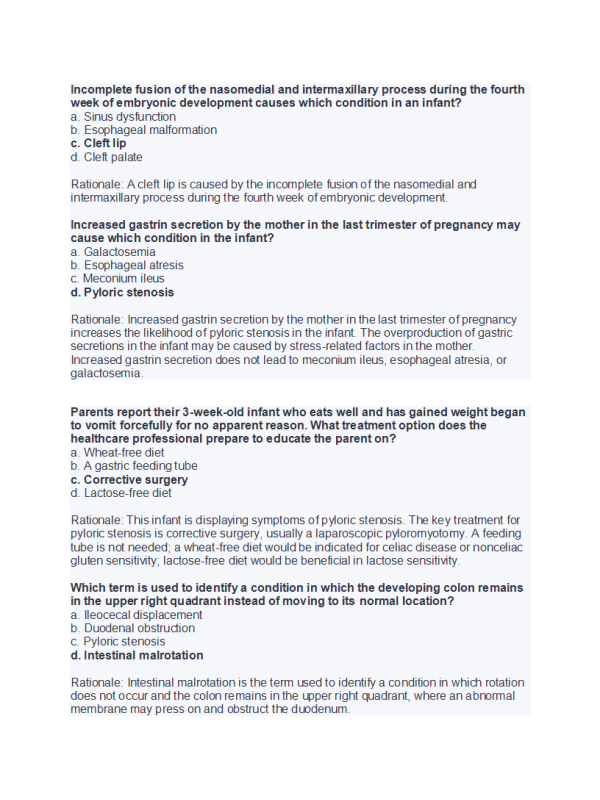
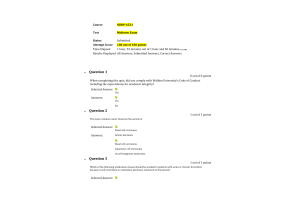
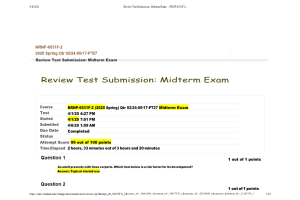
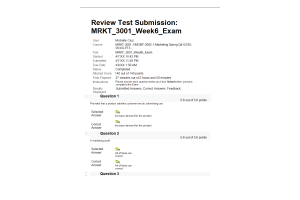
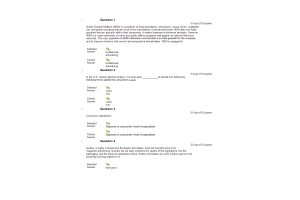
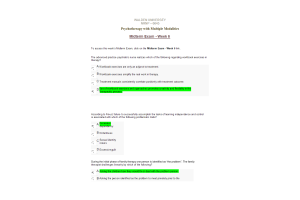
-300x200.png)
